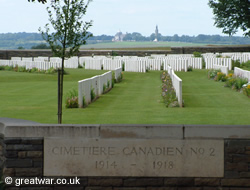Canadian National Vimy Memorial, France
The Canadian National Vimy Memorial is a memorial to all Canadians who served their country in battle during the the Great War of 1914-1918. 60,000 Canadians were killed. Over 11,000 of those killed died in France but they have no known grave. The Canadian National Vimy Memorial bears the inscribed names of 11,168 missing Canadians, killed in action in France but whose remains have not been found or identified. (1)
- Origins of the Vimy Monument
- Location of the Monument on Hill 145
- Design of the Memorial
- Memorial Construction
- Names of the Missing Canadians
- Dedication Ceremony, July 1936
- National Historic Site of Canada
- Renovation of the Monument
- Memorial Park Preserved Trenches, Tunnels and Craters
- Visitor Education Centre, Vimy Memorial Park
- Cemeteries on the Site
- Vimy Memorial Location
- Visitor Information from Veterans Affairs Canada/Anciens Combattants Canada
Origins of the Vimy Monument
A National Memorial
Eight sites on the former Western Front battlefields were given to the nation of Canada for the commemoration of her war dead and all those Canadians who fought there. Five sites were in France and three sites were in Belgium. The Canadian Battlefields Memorials Committee was set up in 1920 by the Canadian Government. This commission was to carry out the organization and administration for a competition to come up with ideas for these eight memorial sites. Initially the idea was to have the same memorial at each site, so that no single site would be seen to appear more important than another.
Ideas for the Canadian National Memorial
A competition for the design of a Canadian memorial was won by a sculptor from Toronto, Walter Seymour Allward. His winning entry was one of 160 ideas submitted to the competition. Of the 160 ideas, 17 shortlisted entries were produced as plaster models. Generally the designs incorporated a single tower, but Allward's design had two pylon towers.

|
Allward was chosen as the winner in October 1921 by the Canadian Battlefields Memorials Committee. The Commission then decided that, because Allward's design was the winning entry, it would be too complicated and costly a monument to put at each of the eight memorial sites. Instead of having the same design at each site, therefore, it was decided to have Allward's design at one site, the design of the runner-up, Frederick Chapman Clemesha at another, and smaller monuments at the other six sites.
A design by Frederick Chapman Clemesha was the idea for a single tower-like structure with the head and shoulders of a soldier in a pose standing with “reversed arms”. This memorial was chosen and constructed as the St. Julien Memorial at Vancouver Corner in the Ypres Salient battlefields.
A Site for the Winning Memorial
The Canadian Government decided that the winning memorial design should be erected as a national memorial in Europe to honour the many thousands of Canadians who had fought with the Canadian Expeditionary Force (C.E.F.) on the Western Front of 1914-1918. Most especially, it would commemorate those who were killed.
In the discussion about where to locate the memorial General Sir Arthur Currie suggested that a national monument should be located on the former July 1916 battlefield of Hill 62, known as Mount Sorrel, near Ypres in Belgium. General Currie had commanded the Canadian 1st Division from mid 1915 and the Canadian Corps from June 1917.
The final decision was made to place the national monument on one of the five Canadian commemorative battle sites in France. It was decided that the monument would be situated on the imposing ridge of high ground at Vimy Ridge north of Arras. This had been the scene of a successful attack by the Canadian Expeditionary Force (C.E.F.) in the spring of 1917 at the Battle of Vimy Ridge (9th to 12th April) during the Battles of Arras, 1917. On the left wing of the Allied attack consisting of Canadian and British Army units, this battle was the first time the four divisions of the C.E.F had fought together as a single formation.
The Memorial Park, a Gift from France
 |
In addition to the land already granted to Canada at the former Vimy Ridge battlefield site, the Canadian Government asked France about the possibility of obtaining more ground for the siting of the national memorial. The Canadian Prime Minister at the time, William Lyon Mackenzie King, suggested that a larger battlefield site could be preserved for future generations as a memorial park.
In December 1922 the French Government granted a larger area of land on the crest of the ridge to the Canadian nation “in perpetuity”. The donation of the land was accompanied by conditions from the French Government that the land was only to be used and maintained as a memorial park and that there would be a Canadian memorial to commemorate Canada's war dead of the 1914-1918 Great War. The area of ground for the memorial park was 117 hectares (290 acres) of land.
Location of the Monument on Hill 145
 |
The monument itself was to be constructed on Hill 145, so called because it was the highest point of the Vimy Ridge at 145 metres (476 feet) above sea level. The ridge runs in a direction from Givenchy-en-Gohelle in the north-west to Farbus in the south-east. On its western side the Vimy Ridge rises gently from Neuville-St.-Vaast to its high point at Hill 145, where there is a much steeper drop to the Douai Plain on its eastern side.
The German Army Secure on the Ridge
Following the First Battle of Artois (27 September - 10 October 1914) the German Front Line had been established by the I Bavarian Reserve Corps on the highest western end of the ridge, protecting the magnificent view across the Imperial German Army's rear areas and their lines of communication converging on Lille and Douai. As a naturally occuring, strategic line of defence it was crucial for the German Army to hold on to it. The French Tenth Army tried to dislodge the Germans twice in 1915 without long-term success and at tremendous loss of over 100,000 casualties. In the Second Battle of Artois (9 May - 18 June 1915) the French 1st Moroccan Division had gained a foothold at Hill 145, but could not hold on to it. The second major offensive by the French Tenth Army to capture the Vimy Ridge was the Third Battle of Artois (25 September - 15 October 1915) but the ridge remained in German hands.
From February 1916 the British Army took over the sector from the French. This was the British XVII Corps. An attack by units of the German I Bavarian Reserve Corps in May 1916 pushed the British a little further down the western slope of the ridge, despite fierce British resistance. The Germans managed to capture some British tunnels and mine craters including the large Broadmarsh Crater.
The Canadian Corps Takes over the Sector
The Canadian Corps took over from the British XVII Corps in this sector of the Western Front from October of 1916. Anticipating an Allied attack on the ridge, the German line at the Hill 145 sector was reinforced by the insertion of the 79th Reserve Division on 26th February 1917. This division had been brought from the Eastern Front to take over the ridge sector between Givenchy-en-Gohelle to Thélus, thus bolstering the German defence on this important ridge. The three regiments in 79th Reserve Division had been newly formed in November 1914 and were mostly made up of experienced infantrymen from prestigious Prussian Guards regiments who had recovered from wounds received in the early weeks of the war.
Canadians Capture Hill 145
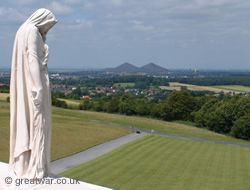
|
At the start of the Battle of Arras on 9 April 1917 all four divisions — 1st, 2nd, 3rd and 4th Divisions — of the Canadian Corps took part in the Battle of Vimy Ridge (9 - 12 April 1917), attacking the German Front Line between Souchez and Écurie. British divisions went into the attack on the right of the Canadians. In a well-rehearsed attack, not without heavy casualties, the Canadians did succeed in pushing forward across the German first, second and third lines to the far side of the ridge by 12 April. The German commanders on the plain in the Second Position (2. Stellung) could see figures moving about on the skyline, these being Canadians. It was decided to make an orderly evacuation from the Second Position and wounded at the casualty clearing station at Vimy were bundled into lorries and driven further to the rear. Ammunition and supply dumps along the railway line east of the ridge were systematically destroyed by German pioneers as the Germans moved out.
Design of the Memorial
The Pylons

|
The two pylons stand 120 feet (30 metres) high from the base of the memorial. They represent Canada and France; one pylon has a carving of the maple leaf for Canada, the other plyon has the fleur-de-lis for France. Both countries shared the sorrow and sacrifice of war.
Sculpted Figures
There are 20 sculpted human figures on the monument.
The Chorus: A group of eight figures high up on the top of the two pylons represent Justice, Peace, Hope, Charity, Honour, Faith, Truth and Knowledge. Peace is the highest figure on the monument, reaching upwards with a torch.
The Spirit of Sacrifice: Between the pylons the group of two figures comprises a dying soldier who has passed a torch to a comrade.
The Defenders: Two groups of figures located at each end of the front wall comprise seven figures called The Defenders. The group of three figures called Breaking of the Sword is on the south corner of the front wall. The group of four figures called Sympathy of the Canadians for the Helpless is at the north corner of the front wall. Above each group a gun barrel with laurel and olive branches represents peace.

|
The Mourning Parents: Two reclining figures on the southern (reverse) side of the memorial, located either side of the steps, represent the mourning mothers and fathers of Canada's war dead.
“Mother Canada” or “Canada Bereft”: A female figure draped in a cloak stands alone on the wall at the north-eastern side of the memorial. She bows her head and is looking down at a stone sarcophogus, representing Canada's war dead, at the base of the 24 foot (7.3 metres) wall below her. The magnificent view across the Douai plain and the location of the old enemy of the time spreads out before her. This figure is called Mother Canada or Canada Bereft, representing the nation of Canada mourning for her dead. The figure was carved from a single 30 tonne block of limestone.
Sarcophagus
A stone sarcophagus is situated at the foot of the front wall of the memorial, which rises above it to 24 feet (7.3 metres). A Brodie steel helmet, as worn by the Canadian soldiers, a sword and laurel branches lie on the sarcophagus.
Memorial Construction

|
The monument was built of limestone, which was found by Walter Allward after a long search for a suitable stone. He found it in a Roman quarry near the town of Seget in the country nowadays known as Croatia. The stone from this quarry had been used by the Roman Emporer Diocletian for his palace at Split. The Seget stone to build the Vimy memorial was transported to France by sea, rail and lorry. The construction cost about 1.5 million Canadian dollars.
The first deliveries of stone for the construction arrived on site in 1927. The large blocks for the human figures did not start to arrive at the site until 1931. The work to complete the memorial took a total of eleven years from when Allward started work on the project in 1925. During the period of construction of the memorial the Imperial War Graves Commission (2) employed French and British ex-Servicemen as staff to lay out the landscaping and roads in the memorial park.
Allward and the structural engineers assigned to the project constructed the monument using a frame of cast concrete to which the Seget limestone was bonded. The foundation of the memorial is made up of about 11,000 tonnes of concrete with many additional tonnes of reinforced steel. The memorial base and the two pylons were constructed using 6,000 tonnes of limestone from Seget. Each of the 20 human figures was carved on site by sculptors working from smaller scale plaster models made by Allward. Each figure was carved at the memorial site under the cover of a temporary type of studio.
Allward's dream to create a monument which would last for many hundreds of years was not to be, however, as the stone and concrete did not react well when bonded together. Within sixty years there were problems with the limestone and its concrete framework. There was erosion in the limestone due to water flowing from cracks in the structure, water damage to the concrete foundations and water entering the gap between the concrete framework and the limestone facing. A major renovation had to be carried out from 2001.
Names of the Missing Canadians

|
The Canadian Government and the Canadian Battlefield Memorials Commission wanted to have the names of more than 11,000 Canadians, with no known resting place in France, carved on the this national memorial. This had not been a feature of the original design. At first Allward was unhappy about carving names on the actual memorial, but after further discussion it was agreed that the names would be included on the memorial. From the early 1930s the names of 11,285 Canadians missing in action in France were inscribed on the walls around the base of the monument in a font specially designed by Allward. (3)
The names of the missing are recorded in the Debt of Honour register in the care of the Commonwealth War Graves Commission. The records can be searched for online in the Cemetery Reports. See the bottom of this page for a link.
Among the names of the missing are four Canadian Victoria Cross winners:
- Lieutenant Robert Grierson Combe, VC, 27th Battalion Canadian Infantry (Manitoba Regiment)
- Sergeant Frederick Hobson, VC, 20th Battalion Canadian Infantry (Central Ontario Regiment)
- Private William Johnstone Milne, VC, 16th Battalion Canadian Infantry (Manitoba Regiment)
- Sergeant Robert Spall, VC, Princess Patricia's Canadian Light Infantry (Eastern Ontario Regiment)
Search for Names on the Vimy Memorial
Search the “Debt of Honour” Register held by the Commonwealth War Graves Commission for names carved on the Vimy Memorial. Go to this link and click on the See Casualty Records button at:
Website: www.cwgc.org Vimy Memorial Casualties
Dedication Ceremony, July 1936
Pilgrims from Canada
The Government of Canada issued over 6,000 free Special Vimy Passports. These passports were provided for people who wanted to make the pilgrimage to France for the unveiling ceremony of the Vimy Memorial and visits to other sites of Canadian sacrifice. Over 6,000 pilgrims set sail for France on five ocean-going steamships, leaving the port of Montreal in Canada on 16 July 1936. The five ships were the S.S. Montrose, S.S. Montcalm, S.S. Antonia, S.S. Ascania and S.S. Duchess of Bedford. The S.S. Montrose also carried 300 wreaths to be laid at Canadian sites on the 1914-1918 Western Front battlefields during the pilgrimage visit. Over 1,000 Canadians also travelled from England.
Unveiling Ceremony
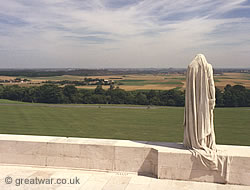 |
The date of the dedication and unveiling ceremony was 26 July 1936. There was a huge crowd of approximately 100,000 people present at the ceremony. Many thousands of them were of Canadian, British and French ex-Servicemen. About 8,000 Canadian Veterans had travelled there from Canada. There were family members of the surviving Veterans and their comrades who had been killed, widows and mothers, dignitaries and royalty. There were also 50 children from the five French communes which had donated the land as a gift to Canada, and another 200 children from Arras.
The memorial was unveiled by King Edward VIII as King of Canada. As Prince of Wales before he was crowned king, Edward had been on the Staff of the Canadian Corps in France during the war. The President of France, Monsieur Albert Lebrun was present to participate in the official unveiling. During the ceremony King Edward pulled a cord to release the Union Flag (Union Jack) which was covering the statue of “Mother Canada” on the northern wall of the memorial.
National Historic Site of Canada

|
In 1996 the Vimy Memorial and the battlefield site surrounding it was established as a National Historic Site of Canada. There are over 950 National Historic Sites of Canada. All but two of the sites are located in Canada and the two sites located outside Canada are the Canadian Nationa Vimy Memorial and the Beaumont-Hamel Newfoundland Memorial on the Somme battlefield (see Related Links below).
The site is maintained by Veteran Affairs Canada/Anciens Combattants Canada.
Renovation of the Monument

|
Cracks and water damage created structural problems and the monument underwent a massive renovation between 2001 and 2006 at a cost of 20 million Canadian dollars. the same Seget limestone was used to make the renovation and repairs. Under the direction of the Canadian Battlefield Memorials Restoration Project the memorial at Vimy was one of 13 Canadian battlefield memorial sites in France and Belgium to have renovation work carried out.
The Canadian National Vimy Memorial was rededicated by Queen Elizabeth II on 9 April 2007. The ceremony was attended by Prince Philip, the Duke of Edinburgh, Canadian Prime Minister Stephen Harper and French Prime Minister Dominique de Villepin. Thousands of people gathered at the memorial for the ceremony, which not only marked the completion of the renovation, but was also the 90th anniversary of the Battle of Vimy Ridge in April 1917.
Memorial Park Preserved Trenches, Tunnels and Craters
Trenches
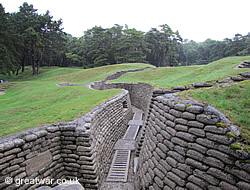
|
The site of the memorial park comprises an area where a section of original Allied and German trenches has been preserved using concrete sandbags and duckboards. This area is open for visiting at all hours. The preserved section of trenches in the Vimy Memorial Park is one of the few places on the old Western Front where visitors can walk though an “original” section of Allied and German Front Line Trenches.
It was during the construction of the Vimy memorial that the principal Canadian engineer working on the site, by the name of Major Unwin Simson, suggested that some of the trenches could be preserved in a more permanent way. This would help prevent naturally occuring damage to them by the weather and undergrowth and the number of visitors wishing to walk through them. While he was waiting for the limestone to arrive on its journey from Seget, Major Simson tasked his workers to rebuild a section of the Allied and the German trenches using sandbags filled with concrete.
Preserved WW1 Trenches at Vimy Memorial Park
Tunnels

|
At the same time as Major Unwin organized the rebuilding of the trench sections in the late 1920s, the entrance to Grange Tunnel Subway, one of the tunnels dug by the Allies on the Vimy Ridge, was rebuilt with concrete. Part of this tunnel was cleared and made safe for visitors and electric lighting was put in.
In the 1980s some of the many tunnels dug into the ridge were explored and made safe for visitors.
A guided visit to the tunnels can be made by prior appointment or by booking on arrival at the Vimy Interpretive Centre (see below). Visiting the tunnels is subject to the weather (the ground can be dangerous when wet).
Craters
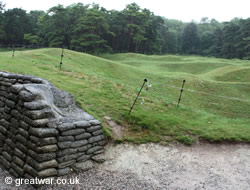
|
Much of the ground in the memorial park was cleared of surface battlefield debris but was deliberately left in its damaged state. Visitors will see the cratered landscape which characterized the battlefields of the Western Front. Pine trees grow in parts of the park and some areas are not accessible to walk through in order to maintain their preserved state and for public safety. Unexploded munitions are likely still under the surface of the ground in parts of the site.
Visitors are respectfully asked only to walk on marked or designated pathways throughout the site.
Visitor Education Centre, Vimy Memorial Park
The first Vimy Interpretive Centre was officially inaugurated at the Vimy Memorial Park on 9 November 1997. A new Visitor Education Centre was opened on 10 April 2017. It is administered by Veterans Affairs Canada/Ancien Combattants Canada. For information about the centre, free guided tours of the memorial and tunnels at the site see our page:
Visitor Education Centre, Vimy
Cemeteries on the Site
There are two British military cemeteries in the memorial park, maintained by the Commonwealth War Graves Commission.
Givenchy Road Canadian Cemetery
Vimy Memorial Location
The memorial is located near the village of Vimy about 5 miles (8 kilometres) north-east of Arras on the N17 to Lens. Just south of the village of Vimy the memorial is signposted. The memorial, the Vimy Visitor Education Centre and the location of the preserved trenches and tunnels are well signposted.
Latitude N 50° 22' 45" ; Longitude E 2° 46' 23"
Opening Hours
The grounds of the memorial, the preserved trenches and cemeteries on the site are free and open for public access all year round.
Two parts of the site do have opening hours. These are the Visitor Education Centre and the Grange Subway tunnel.
The Visitor Education Centre (and Grange Tunnel escorted tours):
- Open daily 09.00 - 17.00 hours
Guided tours of the tunnels and trenches lasts for approximately 50 minutes. Each child under 12 must be accompanied by an adult. The ground is uneven and the visit goes down to a depth of 10 metres underground. In adverse weather conditions the tunnels may be closed.
Visitors are respectfully requested not to walk on the grassed areas near the memorial and only to use the paved paths.
Wheelchair Access
the Visitor Education Centre and paths through the centre of the preserved trenches are accessible for wheelchairs.
The trench system and the Grange Tunnel system are not wheelchair accessible.
Parking
There is free parking at the site.
Toilets
There are toilets available for visitors during the Visitor Centre opening hours.
Enquiries & Visitor Information
Enquiries regarding reservations and visitor information can be made to Veterans Affairs Canada/Anciens Combattants Canada:
Email: [email protected]
Telephone: (from Canada) 011 33 3 21 50 68 68; (from Europe) +33 (0) 3 21 50 68 68
Website: www.veterans.gc.ca Vimy Memorial
Address: Canadian National Vimy Memorial, Route D55, 62580 Givenchy-en-Gohelle, France
Further Reading
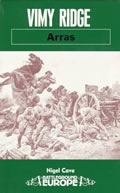
Vimy Ridge: Arras (Battleground Europe Series)
by Nigel Cave
208 pages. Pen & Sword Books (first printed by Leo Cooper), 1996. ISBN-10: 0850523990 and ISBN-13: 978-0850523997
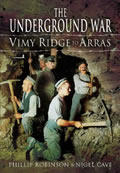
The Underground War: Vimy Ridge to Arras: 1 [Hardcover]
by Phillip Robinson (Author) and Nigel Cave (author)
360 pages. Pen & Sword Military; First Edition edition (19 May 2011). ISBN-10: 1844159760 and ISBN-13: 978-1844159765

Vimy Ridge, 1917: Byng's Canadians Triumph at Arras (Campaign) [Paperback]
by I.A.J. Turner (Author) and Peter Dennis (Illustrator)
96 pages. Osprey Publishing (10 May 2005). ISBN-10: 1841768715 and ISBN-13: 978-1841768717
Related Topics
National Historic Site of Canada: Somme Battlefield
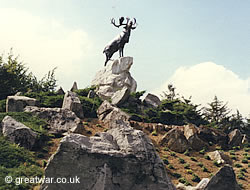
Find out about the other National Historic Site of Canada located in France. This was the place where the Newfoundland Regiment was in action and suffered huge loss in casualties on the first day of the Battle of the Somme, 1st July 1916. At that time Newfoundland was a Dominion of the British Empire. In 1949 it became a province of Canada.
Newfoundland Memorial Park, Beaumont-Hamel, France
St. Julien Memorial at Vancouver Corner, Flanders, Belgium
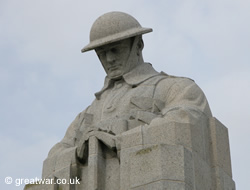
The memorial designed by Frederick C Clemesha, the runner-up in the competition to design a national memorial for the Canadian battlefield memorial sites, was selected for one of the three Canadian memorial sites in Flanders. The memorial commemorates the part played by the Canadian Expeditionary Force (C.E.F.) during the Second Battle of Ypres in April-May 1915:
Canadian St. Julien Memorial at Vancouver Corner
Canadians Missing in Action in Flanders, Belgium
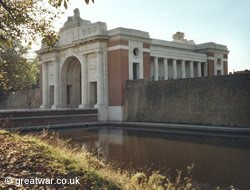
The names of 7,000 servicemen serving with the Canadian Expeditionary Force (C.E.F.) and missing in action in Flanders, Belgium, are inscribed on the Menin Gate Memorial to the Missing in Ypres (Ieper).
Menin Gate Memorial to the Missing, Ypres (Ieper)
Acknowledgements
(1) and (3) The number for those missing in action and named on the memorial as at 2011 is taken from the register of names according to the Commonwealth War Graves Commission. The number of names actually inscribed on this memorial is 11,285. This number now includes 116 individuals whose bodies have been found and identified since the memorial was built with the carved names of the missing.
(2) Formerly the Imperial War Graves Commission, the Commission was renamed the Commonwealth War Graves Commission in 1960.
(CWGC) Diagram of the Vimy Memorial courtesy of the Commonwealth War Graves Commission.
Veterans Affairs Canada/Anciens Combattants Canada.
Website: www.veterans.gc.ca
Vimy Ridge: Arras, Battleground Europe, by Nigel Cave, Pen & Sword Books (first printed by Leo Cooper), 1996, ISBN 0 85052 399 0
Die 79 Infanterie-Division in der Osterschlacht bei Arras, von Joseph Ahlhaus

